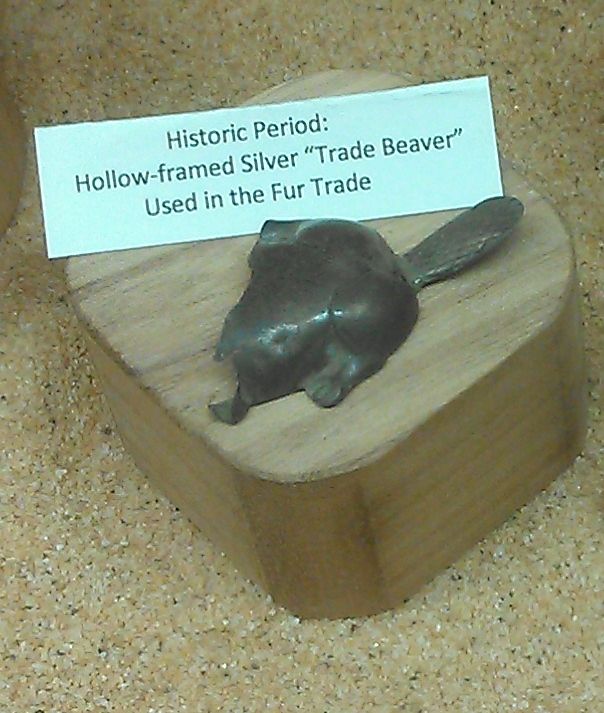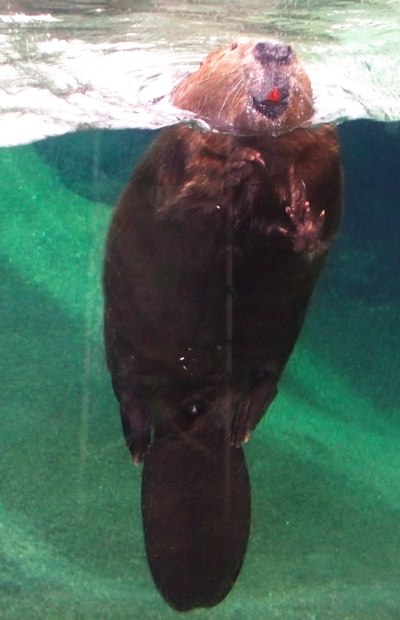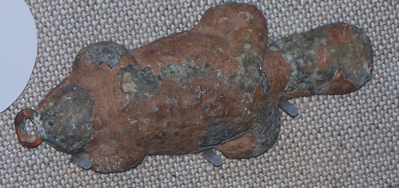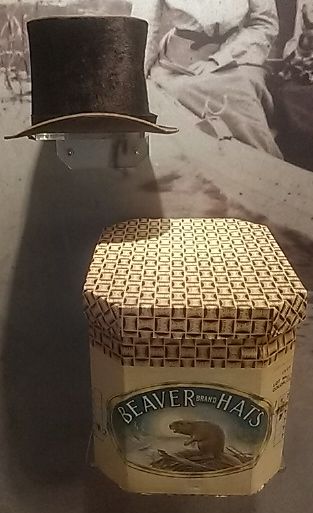Encyclopedia Dubuque
"Encyclopedia Dubuque is the online authority for all things Dubuque, written by the people who know the city best.”
Marshall Cohen—researcher and producer, CNN
Affiliated with the Local History Network of the State Historical Society of Iowa, and the Iowa Museum Association.
FUR TRADE: Difference between revisions
No edit summary |
No edit summary |
||
| Line 52: | Line 52: | ||
The next step in the regulation of the fur trade was to absolutely prohibit the "introduction of liquor into the Indian country." This was accomplished by a measure which was intended to protect the natives against the white trader; and if it worked a hardship on the trader he had only himself to blame. (30) | The next step in the regulation of the fur trade was to absolutely prohibit the "introduction of liquor into the Indian country." This was accomplished by a measure which was intended to protect the natives against the white trader; and if it worked a hardship on the trader he had only himself to blame. (30) | ||
As the westward movement of population advanced, "crowding in closer upon the native inhabitants", the trader's profits decreased. "Only the Indians' removal farther west", whence the fur-bearing animals had already retreated, offered any hope for the "revival of business in furs and peltries." The "scenes of barter and exchange" no longer characterized the eastern border of Iowa but "were being shifted westward as the vanguard of sturdy Anglo-Saxon conquerors with axe and plow began to reach the west bank of the Mighty River". (31) | As the westward movement of population advanced, "crowding in closer upon the native inhabitants", the trader's profits decreased. "Only the Indians' removal farther west", whence the fur-bearing animals had already retreated, offered any hope for the "revival of business in furs and peltries." The "scenes of barter and exchange" no longer characterized the eastern border of Iowa but "were being shifted westward as the vanguard of sturdy Anglo-Saxon conquerors with axe and plow began to reach the west bank of the Mighty River". (31) | ||
By 1836 the beaver had been eliminated as a major source of fur in the Mississippi Valley. Muskrats accounted for 95% of the furs shipped and 75% of the monetary value. (32) By 1854 the great fur companies had moved on. This did not mean that the fur trade ceased to be an important part of the American economy. The total value of United States fur exports increased steadily between 1830 and 1880. (33) Now, however, it was a business that shifted to the western United States where names like Jim Bridger, John Colter, and Jedidiah Smith have often made readers unfortunately believe the only fur trade ever existed. | |||
--- | --- | ||
| Line 63: | Line 65: | ||
3. "Why Did France Take Louisiana Back from the Spanish?" Curiosity.com. Online: http://curiosity.discovery.com/question/why-france-take-louisiana-back | 3. "Why Did France Take Louisiana Back from the Spanish?" Curiosity.com. Online: http://curiosity.discovery.com/question/why-france-take-louisiana-back | ||
4. | |||
32. Gilman, Rhoda. "Last Days of the Mississippi Fur Trade," Minnesota History, Winter 1970, p. 123 | |||
33. Ibid., p. 124 | |||
[[Category: Industry]] | [[Category: Industry]] | ||
Revision as of 19:59, 8 June 2014
FUR TRADE.
The dream of the founders of New France in America to establish "a chain of well-garrisoned forts along the St. Lawrence River to the Ohio and thence down to the Gulf of Mexico" was only a part of their plan "to retain the trade monopoly in the furs and minerals of the West" and thus "check the encroachments of their aggressive neighbors and enemies" the British and the Spanish. (1) This dream was at first translated into "forts" - actually "traders" huts surrounded perhaps with high fences of pickets or split logs" - along riverbanks in the valley of the MISSISSIPPI RIVER.
About 1690 Nicholas PERROT erected two or three forts or trading posts along the Mississippi River above the mouth of the Wisconsin River. Natives exchanged pelts for trinkets. Later Perrot built a "fort" opposite the LEAD mines - probably "near the site of Dunleith on the Illinois side" of the river - thus bringing his wares within easy reach of the customers. (2)
Other Frenchmen engaged in considerable trade with the Indians. Posts were established at various places in Minnesota, Wisconsin, and Illinois. The French dream of an American empire came to an end, however, with the English victory in the French and Indian War. French land holdings were transferred to Spain in 1762 so that they would not be lost to the English. (3) During the period of Spanish control a bitter contest was waged with the English over the Indian trade. The Spaniards complained that the Sioux and the Ioways were unfaithful, giving to the English the fruits of their hunting, but the liberal presents of the British were not able to win over the Sauk and Fox tribes. (4)
In 1794 the Spanish Governor gave Andrew Todd, "a young and robust Irishman", the right to the exclusive trade of the Upper Mississippi. "Don Andreas", as he came to be called, appears to have been successful in the undertaking -sending vast stores of goods up from New Orleans and bringing back furs. Two years later James Mackay in the employ of the Spanish Commercial Company of St. Louis reported that the "traders of the River Monigona (Des Moines) have sent twelve horses laden with goods to trade with the Panis (Pawnees) and the Layos (Loups) on the Chato (Platte) River." He adds furthermore that he "would be glad to be able to deal them a blow on their return." The struggle against British aggression seemed to be still in progress. (5)
That same year, 1796, Julien DUBUQUE made claim to lead mines. Todd, however, retained his monopoly of the Indian trade, insisting that the Spanish government absolutely prohibit Dubuque from trading with the natives. (6) With the death of Todd in 1796, the monopoly seems to have ended for the grant made in 1799 to Louis Tesson near the present town of Montrose in Lee County and the one in 1800 to Basil Giard at what is now McGregor in Clayton County contained no such restrictions. These three men, Dubuque, Tesson, and Giard, were probably the first fur traders who actually lived in Iowa; although other and earlier transient traders made frequent excursions into this region. (7)
A period of more active interest in the fur trade began about the year 1800. The first trader of the new commercial era was Jean Baptiste Faribault. An agent of the North West Company operating out of Canada, he established a post called "Redwood" located some two hundred miles above the mouth of the Des Moines River, probably somewhere above the present site of Des Moines. Within a year after his arrival he had collected enough furs to arrange a trip to the mouth of the river where he "delivered them to Mr. (Louis) Crawford, one of the accredited agents of the Company." During the four years Faribault remained in charge of this lonely trading post he saw no white men but his own assistants, except on his annual trip to the mouth of the river. (8)
"High prices" were often charged by the traders. It has been estimated that the "Ayouwais", a tribe of some eight hundred Indians located about forty leagues up the river "Demoin", annually consumed merchandise valued a thirty-eight hundred dollars for which they gave in return six thousand dollars worth of "deer skins principally, and the skins of the black bear, beaver, otter, grey fox, raccoon, muskrat, and mink." (9) In 1804, following the purchase of the Iowa country by the United States, the government agreed to establish a post to allow the SAUK and FOX to obtain goods "at a more reasonable rate" and incidentally "to put a stop to the abuses and impositions practiced upon them by private traders." As a result of this treaty Zebulon M. PIKE set out the following year on his expedition to the source of the Mississippi with instructions "to select suitable sites for military establishments and a trading-post". (10)
It was not until 1808, however, that the United States government began to keep its promise to the Sauk and Fox by actually giving the necessary orders. This fort, with its factory, was located on the Mississippi River about twenty miles above the mouth of the Des Moines River and was called Fort Madison. It was the first government post to be erected in Iowa. Trade with the Sauk, Fox, and Ioways flourished in spite of the opposition of British traders and the unfriendly attitude of their chief supporter, Black Hawk. According to an inventory in 1809 the "Le Moine Factory" appeared to be a healthy institution showing "merchandies, furs, pelts, cash on hand, and debts due" to the value of nearly thirty thousand dollars. (11)
Trade along the Mississippi River and its tributaries - the Des Moines, the Skunk, the Iowa, and the Turkey rivers particularly - flourished. The forts, factories, and private establishments located along these waterways - such as Fort Madison, Dirt Lodge (at the Raccoon Forks of the Des Moines River), Redwood, Tesson's place at the head of the Des Moines Rapids, Flint Hills (Burlington), the Dubuque Mines, and Giard's post opposite Prairie du Chien, all on Iowa soil, and Prairie du Chien near the mouth of the Wisconsin River - were the centers of the "Indian trade" in Iowa and the surrounding territory. (12)
It was during this period that encouragement was given to the exploitation of the vast region drained by the Missouri. No sooner had Lewis and Clark returned from their expedition in 1806, than that picturesque character Manuel LISA began the operations that made him the "trade maker" of the newly opened country. In 1807, well supplied with merchandise, he began the first of twelve or thirteen long and dangerous trips up the Missouri. He erected several forts with their accompanying trading posts, one of which was located about eleven miles above the present site of Omaha. There Lisa spent several profitable winters promoting friendly relations with the Indians - an art in which he had no superiors - and acquired a considerable harvest in furs from the natives of western Iowa. (13)
With the construction of Fort Madison, the government appears to have become committed to the policy of establishing posts with the intention of driving out private traders. By 1811 there were ten such "forts" in operation in the upper Mississippi Valley, only one of which was in Iowa however. In that same year Nicholas Boilvin recommended that a new fort be situated at Prairie du Chien, for many years the headquarters of the Indian trade of northern Iowa. The proximity of this locating to the lead mines also made it an ideal spot, particularly since the tribes of the region had during the past year "manufactured four hundred thousand pounds" of lead "which they exchanged for goods." It appears that they had abandoned hunting for the most part "except to furnish themselves with meat". The lead "manufactured" had been bought by Faribault, then located at Prairie du Chien as a private trader. Boilvin considered it a good stroke of business if the Indians could be encouraged to engage in mining as a regular occupation. Lead, too, was not perishable and was "easily transported"; whereas pelts were bulky and large quantities spoiled every year before they reached the market. (14)
During the War of 1812 Manuel Lisa was made sub-agent for all the tribes of the Upper Missouri and his work was very effective in defeating British plans in the West. (15)
The war, however, brought the government experiment at Fort Madison to a close. Being poorly situated, the garrison there was subject to repeated attacks by the Indians. This hostility, said to have been of British origin, resulted in frequent requests by the commandant for relief. Finally, being "reduced to the direct extremity and driven to the verge of starvation" the garrison decided to abandon the post and escape. Digging a trench to the river the soldiers were able to elude the besiegers, remove their "provisions and property", and gain "their boats by crawling out on hands and knees . . . leaving the fort wrapped in flames to the enemy's utter surprise." (16)
After the War of 1812 the government in Washington once more undertook to promote friendly relations with the tribes. In order to reserve the trade for Americans, however, Congress "at the instigation of John Jacob Astor" passed a statute prohibiting "foreign merchants or capital" from "participating in Indian trade within United States territory." Aimed particularly at the British, the law enabled Astor to buy "the interests which the gentlemen of Montreal held in the South West Fur Company" and to reorganize it as the American Fur Company. In addition the government, in accordance with the requests that had for so long been ignored, at last erected a factory at Prairie du Chien. (17)
American domination and control of the fur trade was not easy to secure. Capital and men "to bear the fatigues, and brave the dangers incident" to the wilderness commerce were not always available. Accordingly, the Indian Agents were given "the exclusive right of granting trade licenses to foreigners". Bonds were required to insure compliance with the provisions of the law, particularly with reference to carrying liquor into the Indian territory. (18)
In actual practice, the new policy was abused. A foreigner of undesirable character being unable to secure the necessary license often resorted to a ruse. By employing an American to take out the license the alien, accompanying the expedition as an "interpreter" or "boatman", would, as soon as the Indian agencies were passed, assume control of his property and carry on his business as usual. (19)
Such was the character of the men frequently employed by Astor - French Canadians who otherwise could not have engaged in the trade. The Secretary of War recommended that every facility be afforded Astor and his agents consistent with the laws and the regulations. Moreover, instructions were given to issue licenses to any person that Ramsay Crooks, the agent of the American Fur Company, might designate. Headquarters were maintained at Mackinac Island and trading posts were in time established at strategic points from there to the Pacific coast. The trade of the Iowa country was handled chiefly through Prairie du Chien. At first the policy of the American Fur Company was not to trade directly with the Indians but to outfit private traders and buy the furs from them. (20)
In 1816 troops were landed at Rock Island to build Fort Armstrong. Accompanying the soldiers was an Englishman by the name of George Davenport, later "destined to exert a tremendous influence upon the Indians of the neighborhood." (21) At first "content to furnish the troops provisions" he decided the following year to enter the Indian trade. He erected "a double log-cabin and store-house" on Rock Island a short distance from the fort, "purchased a small stock of goods", and proceeded to gain the confidence of "the hostile Winnebagoes" located on the Rock River. There he lived, building up a profitable business with the Indians of eastern Iowa until he was murdered by a band of outlaws in 1845. (22)
The system of government factories was entirely successful. Private traders made bitter complaints against it and the natives for whose benefits the scheme was devised were not satisfied with its operation. The British traders continued to take an undue share of the business "by trading rum for furs, by selling better goods on credit, and by reason of their marriage to Indian wives." The natives lost confidence in the government since the goods sold at its factories were of poor quality. (23)
In 1820 the Secretary of War, John C. Calhoun, sent Rev. Jedidiah Morse on a tour of the West to learn the facts. He found that private traders had "secured from the Indians in the very shadow of the walls of the government trading-house at Fort Edwards 980 packs of all sorts of furs and peltries valued at $58,800". (24) George Davenport, with headquarters at Rock Island, traded also at Flint Hills and the mouths of the Iowa, Wapsipinicon, and Maquoketa rivers. Dr. Samuel Muir, located on an island opposite the Dubuque mines, and Maurice Blondeau, who maintained a trading house above the mouth of the Des Moines River during almost the entire first quarter of the nineteenth century, each did a flourishing business. The government had in reality been crowded out of the fur trade, so that the Morse report, unfavorable to the continuance of the system, was readily accepted. (25)
The act abolishing the government factories, passed on June 3, 1822, was in some respects unfortunate in its results. Private traders without considerable supervision and regulation were in many instances not above resorting to improper methods. According to one authority the "rapacious system of exploitation by means of credit and whisky" now came to be the usual means of business. (26)
The heyday of the American Fur Company was in sight. "Having pushed government factories to the wall, Astor now proceeded to grind smaller competitors out of existence". It was also true that traders whose volume of business had reached considerable proportions - Maurice Blondeau, George Davenport, Russell Farnham, and others operating in the Iowa country - were finally induced to cast their lot with "the first American monopoly". (27)
Dissatisfaction soon developed due to the practice of sending out "runners to secure credits and follow the hunters to their places of chase". This method was particularly corrupting to the Indians for with an ever-present supply of liquor the trader could secure pelts when the natives were in no condition to drive an honest bargain. The practice was therefore made illegal by an act of Congress in 1824. Furthermore, the law made it "the duty of Indian agents to designate, from time to time, certain convenient and suitable places for carrying on trade", requiring all vendors of goods to do business at the places indicated and at no others. (28)
These new regulations as a matter of fact pleased neither the traders nor the natives and many and loud were the complaints. The western movement of population had brought to the frontier many men and who had no hesitation selling whiskey to the natives. Indeed, the problem of restraining the natibes living near the settlements from the use of liquor was impossible. The "beverage which seemed to fascinate all Red Men" induced them to visit "the various little distilleries and Grocery establishments" and exchanged their money, furs, and peltries for rum. This being the case it was not surprising that frequently the traders who had advanced them goods on credit were left in hard circumstances - the Indians being induced by whiskey "to carry the produce of their winter hunts to others." (29)
The next step in the regulation of the fur trade was to absolutely prohibit the "introduction of liquor into the Indian country." This was accomplished by a measure which was intended to protect the natives against the white trader; and if it worked a hardship on the trader he had only himself to blame. (30)
As the westward movement of population advanced, "crowding in closer upon the native inhabitants", the trader's profits decreased. "Only the Indians' removal farther west", whence the fur-bearing animals had already retreated, offered any hope for the "revival of business in furs and peltries." The "scenes of barter and exchange" no longer characterized the eastern border of Iowa but "were being shifted westward as the vanguard of sturdy Anglo-Saxon conquerors with axe and plow began to reach the west bank of the Mighty River". (31)
By 1836 the beaver had been eliminated as a major source of fur in the Mississippi Valley. Muskrats accounted for 95% of the furs shipped and 75% of the monetary value. (32) By 1854 the great fur companies had moved on. This did not mean that the fur trade ceased to be an important part of the American economy. The total value of United States fur exports increased steadily between 1830 and 1880. (33) Now, however, it was a business that shifted to the western United States where names like Jim Bridger, John Colter, and Jedidiah Smith have often made readers unfortunately believe the only fur trade ever existed.
---
Source:
1. Robeson George F. "Fur Trade in Early Iowa," The Palimpsest, Volume VI, January 1925 No. 1, Online: http://iagenweb.org/history/palimpsest/1925-Jan2.htm
2. Ibid.
3. "Why Did France Take Louisiana Back from the Spanish?" Curiosity.com. Online: http://curiosity.discovery.com/question/why-france-take-louisiana-back
4.
32. Gilman, Rhoda. "Last Days of the Mississippi Fur Trade," Minnesota History, Winter 1970, p. 123
33. Ibid., p. 124






